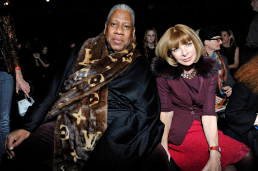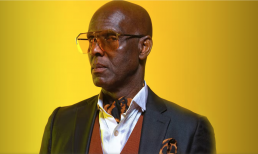Style
Marketing Lessons From The Fashion Industry
Marketing Lessons From The Fashion Industry
To me, the greatest marketers are fashion icons. And by fashion icons I don’t mean supermodels or the best dressed celebrities. I mean the ordinary individuals who put in captivating work that suddenly makes them seem extraordinary. Some of my top fashion icons are André Leon Talley, former editor-at-large of Vogue magazine; Dapper Dan, the underground creative genius that bootlegged luxury fashion to pimps and gangstas; Diana Vreeland, who worked as a columnist and editor of Harper’s Bazaar and later served as the editor-in-chief of Vogue magazine, and finally Anna Wintour, the private and mysterious British Journalist who has served as editor-in-Chief of Vogue since 1988, and Global Chief Content Officer for Condé Nast since 2020.
I study the work and follow the moves of these four individuals because I believe their subject matter knowledge is endless, obsessive passion is contagious, thinking is insanely divergent, product appreciation is deep, and the rebellious attitude to getting their work done is alluring to me. These five variables are the essential ingredients that are consistent across each individual’s profile, and I believe makes them extra-ordinary. Fashion or not, they are extremely savvy marketers of concepts and products who I believe can sell anything as long as they are interested in it or care about it enough. It’s like what Jay-Z said in ‘Dirt Off Your Shoulder’ – “I’m the realest that run it, I just happen to rap”.
So, these are incredible humans, but why are they great marketers? First factor we will explore is Vanity. As you know, the fashion world has been criticised for being unreal and vain. People in the industry supposedly act as if fashion is the true religion (pun intended), and nothing else exists – and I wonder why that is so wrong. If you don’t believe so much in the work that you do, how do you expect to make someone else believe in it? If Steve Jobs did not have a blinding belief in interface and experience design, would he have been able to convince others to become advocates enough to make Apple attain the status of the world’s most valuable company? I think not.
Anna Wintour is considered the most powerful woman in the global fashion industry, and I’m not even sure she’s ever sewed a stitch of fabric. Fashion designers treat her like the Queen of England and consumers are constantly trying to demystify her. But what makes Anna so powerful, is not only the mystery that lurks behind her dark shades and wicked bobs, it is that she captains Condé Nast – the ultimate lifestyle brand conglomerate, and a melting pot of vanity – which is a guaranteed marketing machine that sells out anything and anyone.
Next factor to look at will be Personality. Everyone that was or is a leading voice in the fashion industry, is an absolute original. From physical appearances to personal idiosyncrasies, the four aforementioned people are very authentic and unapologetic about how they carry themselves and how they are perceived. This comes across authentically in their personal branding which makes them absolute magnets to their various tribes. It makes connecting with their audiences easier, and it makes persuasion and conversion easier. While reading Dapper Dan’s memoir aptly titled ‘Made in Harlem’ – I noted an interesting story he told about touring Africa and ending up in Senegal, where the bulk of his money was spent buying beautiful fabrics which tailors made into nice suits for him. This almost got him stranded in Africa by the way. Dap likes to look fly, and one thing that is consistent about him and all the other fashion icons I follow, is the compulsive need to cultivate and appreciate style.
Another important factor is Showmanship. If you skim through fashion history; study roll-out plans, exhibitions, and sustaining conversations to drive sales and talkability, you’d note that fashion is highly histrionic. Fashion designers and some fashion editors are the greatest showmen. They know how to put on a show or magazine that makes everyone stop, point and talk. To me, Diana Vreeland still remains the only fashion editor who understood the charm of the human pose, the soul of an outfit, the personality of a typeface, and the architecture of a brilliant layout. She was the master of detail and exaggeration – and she embodied these two elements completely. Checkout her documentary ‘Diana Vreeland: The Eye Has to Travel’ whenever you can.
The final factor that makes fashion icons marketing geniuses is Sustenance. They understand the art of sustaining conversations long after exhibitions are over. The phrase ‘paint a picture with words’ was probably originally used to describe André Leon Talley. His deep love for style, taste and character, merged with his vast knowledge of the fashion industry helped him connect with fashion designers on a purely artistic level. This enabled him to tell the stories of their personality and collections long after the last model had left the runway.
Why You Should Care About The Fashion Industry
Why You Should Care About The Fashion Industry
Do you ever wonder why people love to hate the fashion industry? I mean I love it, but I cannot speak for the rest of you. What I love about fashion is not even the industry, and as much as I’d like, it is not the style, beauty and glamour. What truly draws my attention to the fashion industry is the image it contributes to, the characterization of the personality at a time in history (in the case of fast fashion), or of all time (in the case of more classic apparels).
People talk a lot about the zeitgeist – which is basically the defining spirit or mood of a particular period of history as shown by the ideas and beliefs of the time. I believe fashion is the zeitgeist, fashion is the mood, and fashion is the emotion. Fashion is one of the most underrated elements of a social structure. People assume because it is just clothes and accessories, then it must be vain – whereas fashion is the backbone of a lot of ‘serious’ societal institutions.
Think of uniformed workers – policemen, pilots, doctors, nurses, soldiers, traffic wardens. When we look at them, we automatically perceive them as figures of authority, in a way, their image alters our behaviour, simply because of the symbolism the clothing represents. Take the same people out of the uniform and they become just any regular Joe. The different uniforms have different styles and a certain kind of beauty attached to their structure, color theme and texture. But ultimately, it is the image that the uniform evokes, that is more powerful.
Fashion is beyond the runway. Let me explain what that means. If you google the word ‘Fashion’ right now, there are two definitions you will find, the first is; Fashion – ‘a popular or the latest style of clothing, hair, decoration, or behaviour’, the second is; Fashion – ‘a manner of doing something’. In this article, I’m exploring what the second means in the context of identity, personality, style, perception, communication and culture.
Simply put, if society was broken down like the anatomy of a human, fashion will be the blood. The first time I understood the depth and reach of the fashion ecosystem – I was hanging out with my Landlord in Opebi, Lagos on a Sunday evening. He paints interesting works of art and has some degrees in Art History. He explained how fashion is literally the material element in the definition of culture (for context, culture is defined as the material and immaterial elements of any society). Think of any time in history, what do you remember it by? – the clothes, the make-up, the accessories, the styles, basically.
We criticise Nollywood and Hollywood for this constantly – “Oh this movie is set in the 70s? Why is her makeup that way? That was not the shoes of the 70s”. We determine time in history by the things we place the least emphasis on; cloth structure, shoes, bags, pieces of jewelry, makeup, slang, wig type, even scents.
At this point, if you’ve seen ‘Devil Wears Prada’ – you’d remember the scene where Meryl Streep schooled Anne Hathaway about how her dismissive opinions about fashion was totally unwarranted, because the scrumpy sweater Anne had on, was determined through the ‘frivolous’ activities that she thought were inconsequential.
Fashion is the most authentic expression of self, expression is art, art is history, and history determines the perception of a society. Fashion has certainly been my backbone. It reminds me of who exactly I think I am when my insecurities are doing a madness. It has also been a long journey to figuring out what my style is, because I have found out that not everything I admire will look good on my body structure.
Everyone that wants to be successful in life needs to go through the process of figuring out what their style is. It sounds so banal and unnecessary but trust me, dedicating the time to understand what works for you and makes you feel like your ideal self will totally change your life. You will feel more confident and certain. Study the feel of the types of textiles that make you feel at home, e.g. as much as I like jeans, it does not work for me at all, I have discovered that I feel more at home in soft and free textiles, makes me feel loved and appreciated.
Study colors, study prints, study cloth structures, study cuts – download Pinterest, feed the algorithm, and it will help you. You will know what you like, don’t shrink yourself to fit in, do mood boards of your unique selections, and invest some money into bringing them to life. No matter how imperfect or insecure you feel, this exercise will make you whole – you will feel worthy, worthy of opportunities, worthy of trying out, worthy by being enough, worthy by feeling enough, worth that can only be gotten from physically wearing clothes.


